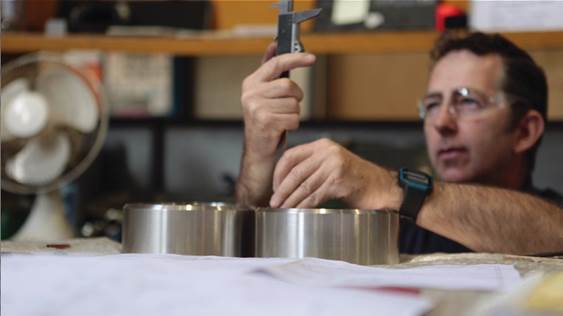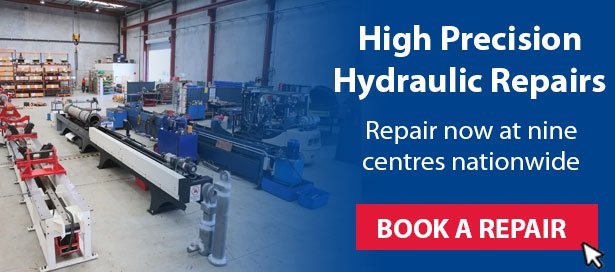Returning a hydraulic cylinder to peak operating performance is a methodical process that requires both knowledge, experience and sophisticated equipment. Correct processes must be followed from start to finish and care and attention must be paid at each stage to ensure quality standards. Every cylinder leaves evidence that offers clues as to the reason for failure, which must be addressed to ensure proper function and avoid repeated failures. Lack of diligence at any point or improper handling will result in a cylinder that does not perform correctly and at best has a shorter lifespan, at worst will fail very quickly.
So with this in mind, we’d like to give you a look at our end to end hydraulic cylinder repair process and show you what it takes to take a cylinder that has seen better days and transform it into a like-new component with performance very close to that which it possessed when it left the factory.
The Correct Hydraulic Cylinder Repair Process
Step 1: Disassembly
The repair process starts with a methodical disassembly of each cylinder - no matter how large or small. Berendsen’s repair divisions maintain heavy overhead cranes and large and powerful disassembly rigs and benches enabling our facilities to handle large cylinders with ease.
The disassembly procedure should be highly practiced. Cylinders should be correctly prepared and secured. High-quality equipment is necessary not only to cope with large cylinders but also to ensure the disassembly process is controlled. Damage during disassembly should be avoided. Not only does it increase the cost of repair, it makes it harder to diagnose the actual cause of hydraulic cylinder failure. Making it more difficult to distinguish between damage caused during disassembly and damage as a result of normal operation.
Correct rigs, tools, and meticulous procedures are an important first step to a high-quality repair.
WATCH THE HYDRAULIC CYLINDER REPAIR PROCESS
Step 2: Inspection & evaluation
Every cylinder is treated the way a forensic scientist would conduct an investigation. An experienced technician examines the failed cylinder for clues such as fractured, glazed or swelling seals, scored or asymmetrically worn piston rods, ballooned barrel tubes or cracked welds.
Referencing manufacturers information and drawing on years of experience, the technician also measures each component with highly accurate digital and manual devices to assess cylinder condition including bore, piston, gland and rod wear, crack detection, chrome hardness and thickness, and surface finish. Each part is checked to confirm that it is within spec for tolerances.
Step 3: Selecting & sourcing replacement parts & seals
Any part that exceeds the tolerances for the cylinder type or the manufacturer's specifications will be sourced or machined from scratch in our fully equipped machine shops. Berendsen maintains appropriate stock levels of common cylinder components in our storehouses. We also maintain excellent OEM relationships and regularly source components direct from the manufacturer where required.
Likewise, we maintain a strong partnership with Hallite Seals, who offer fast access to every type of cylinder seal imaginable. And Hallite can custom-engineer seals to our specifications when required.
In some cases, improved parts and seals may be selected and sourced to ensure better performance and cylinder life. For example, seals with a higher heat or duro rating may be chosen if the cylinder presents symptoms of excessive seal fracturing.
Step 4: Designing components & running reliability simulations
In the case of unusual or uncommon parts that are hard to find, too expensive to procure from other sources, or take too long to arrive, Berendsen’s engineering team can custom-design components on sophisticated engineering software. This software features reliability simulation capabilities that will analyse the performance of the part to ensure performance and longevity. This ensures that the re-engineered component will be as good - and in some cases better than the original part.
Step 5: Machining, welding & reconditioning
Berendsen’s cylinder repair divisions around the country feature advanced CNC milling machines as well as lathes, large scale boring machines, automated honing stations and other devices capable of manufacturing and restoring all components to factory specifications.
Any part that cannot be sourced from the manufacturer or other sources cost-effectively can be manufactured on-site. For example, barrel tubes are often manufactured in this way, which drastically cuts down on cost and turnaround times.
Welding processes, including aluminum bronze overlay and submerged arc welding, are employed to reclaim worn clevis eyes, pistons, spigots, and other components, before machining to original specifications.
At all times, meticulous repair procedures and quality standards must be upheld to ensure each reconditioned component conforms to manufacturers specifications and design tolerances.
Step 2: Sandblasting of barrels & other components
Large sandblasting facilities can accommodate barrel tubes, clevises and joints, and other components - stripping flaked paint and rusted surfaces and stripping the unit back to bare metal in preparation for painting.
Step 3: Hydraulic cylinder rod restoration
Piston rods are ground and restored to original specifications using advanced surface engineering processes, including industrial hard chrome plating, sulphamate nickel plating, laser cladding, and high-velocity oxygen fuel spraying.
Berendsen operates a fully equipped industrial hard chroming facility with 2 large stripping tanks, 5 grinding machines, 4 plating tanks and 2 linishing machines. This facility can accommodate components of many different sizes and dimensions - including very long cylinder rods. The staff of this facility have decades of experience and are well-versed in the craft and science of hard chroming, which is a highly technical and very difficult process that requires a skilled pair of hands and an experienced eye at every stage.
This in-house chroming capability ensures access to consistent high-quality chrome products and contributes to the fast turnaround of cylinder repairs. It also adds to the cost-effectiveness of all repairs, giving chroming production added economy of scale and ensuring costs are controlled by Berendsen.
Step 6: Reassembly
Experienced technicians make use of the cranes and benches to reassemble each reconditioned cylinder. The same rigorous procedures and high-quality equipment is employed in reassembly to ensure correct installation of parts that must fit together very tightly. It is important to avoid damage or incorrect installation at this point, as this would severely impede performance and lead to rapid wear and failure. Berendsen’s technicians assemble thousands of cylinders every year and follow strict assembly procedures. Maintaining cleanliness levels to prevent internal contamination, following correct assembly taking care not to damage or incorrectly install sensitive components such as seals and glands.
Step 7: Testing
Testing is extremely important to ensure that the cylinder performs to the required specifications and can develop the correct pressure without failure. Berendsen operates sophisticated testing stations and customer-specific testing procedures are performed for immediate verification of cylinder integrity with up to 600 bar static pressure.
An improperly machined or reassembled cylinder will be quickly discovered at this point in the process.
Step 8: Painting & finishing
Once assembled and given the OK after testing, the last step in the process is to give the newly restored a fresh coat in our in-house paint shops. With a protective layer of hard-wearing industrial paint, the outside now matches the inside, signalling that the cylinder has completed its journey. It has gone from a cylinder that has seen better days to one that has many more years of life left to give.









Leave A Comment